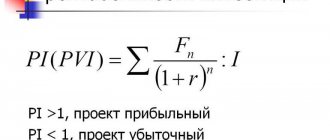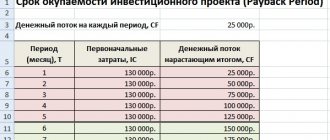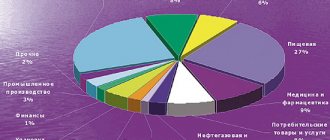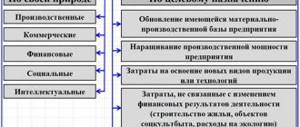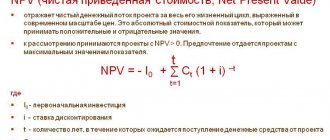Gross investments are the investor’s total investments in an investment object, no matter in what form they are made, and on what part of the object they are spent.
Of course, gross investment is a category of real investment, the objects of which are the fixed capital of enterprises and organizations, their working capital, construction and major repairs of buildings and structures, scientific and technical products, and intangible assets. However, financial investments can also be considered as gross investments. This occurs when a financial investor initially purchases shares of a company, issued by that company specifically to receive investment for development. Further resale of these shares does not count as a gross investment, since after the initial sale there is only a change of ownership of the shares.
The role of net investment in the economy
Financing production is necessary for any enterprise to ensure sustainable development.
Let's look at a simple example. The company is going to expand production. A block of shares is issued in order to then purchase equipment and construct facilities. Shares are starting to sell. In this case, the income received will be considered investment income only after the end of the auction. Private investments are funds received from the sale of shares. Sometimes investment is provided by individuals, banks, and investment companies.
Nowadays they are increasingly relying on foreign capital. In this case, private investments are investments made by foreign companies. But attracting foreign capital is not so easy. Everything here will depend on the direction of activity, the demand for products on the world market.
There is another way to obtain financing. In this case, private investment is the investment of own capital by the founders of companies. Unfortunately, it is not always possible to realize this opportunity. This is due to economic risk: it is advisable to invest money in different projects, wanting to reduce the level of risk.
Reinvestment and gross investment
Renovation investments serve to preserve capital employed in the production process. And net investment involves the use of net retained earnings for capital investments in excess of the estimated or actually formed depreciation fund. In other words, net investment is capital investment that leads to an increase in the size of fixed assets during their expanded reproduction.
Essentially, net investments are realized as a result of the company’s completely natural desire to develop, increase capacity, and open new production facilities and areas of activity. This is the nature of a business moving through the stages of its life cycle to its peak. And even at the maturity stage, as a rule, the development process does not stop, but only slows down.
I'll say more. In the current not entirely prosperous conditions of the Russian economy, in a situation of hidden and direct inflation, renovation investments do not even cover the needs of simple reproduction. For example, 5 years ago a car was purchased for cargo transportation; the depreciation period according to the enterprise’s accounting policy has expired, i.e. its entire cost is written off as expenses. However, over the past years, the price of such a car has doubled, and the accumulated amount of wear and tear is only enough to buy half of a new one. It turns out that part of simple reproduction occurs due to pure investment.
However, net investment is fundamentally made with the goal of increasing the volume of output produced: products or services. The fixed capital employed in production increases in value and quantity. Gross investments or gross investments are considered as the result of the sum of renovation and net investments. Thus, gross investments include the total volume of capital investments of the company for the reporting period.
Net investments and their dynamics determine the level of development of the company in economic and market aspects. It is advisable to draw conclusions on such dynamics on an annual basis based on a synthetic analysis in the context of the entire fixed capital of the enterprise. To calculate gross investment, a special formula is used to establish the relationship between the two types of investment.
Formula for the relationship between two forms of real investment
In this article, we examined the main types of investments from the point of view of the directions of reproduction of fixed capital. Net investment, as an indicator of the company’s true development through profits “cleaned” from accumulated depreciation, is a significant indicator of the strategy being implemented. The statistics of this indicator are important both for external investors and lenders in assessing the health of the business, and for senior management, including the financial director. It helps to assess the stage of the enterprise’s life cycle, as well as develop financial and investment strategies for the future.
A few nuances of investing
Let's consider several situations.
- Most economists believe that the key indicator of a company's development is net investment activity. This is quite objective. In this case, net investment is a fairly serious indicator of the success of the company’s work and development. When companies develop well, they begin to inspire confidence among investors. And there is a flow of private investment. As a result, non-current assets are also growing.
- If the investment indicator tends to zero, we can conclude that there are problems in the work: growth has stopped. In this case, there will certainly be negative consequences.
- A critical situation is a drop in net investments, their negative value. This is already followed by bankruptcy. To save the company, you will need to make accurate calculations and be sure to attract financing.
When this financing is carried out on a state scale, investment necessarily has a positive effect on the volume of national income. Investment becomes especially important due to rising inflation. Funding must cover this indicator.
What is important for investors?
It is necessary to understand that attracting investments is not so easy. Investors have a lot of choice. They take the utmost care in identifying the most promising objects for financing. They take into account the volume of net profit and be sure to monitor the flow of funds. All financial flows must be objectively reflected in the financial statements. The size of the investment is of great importance here.
Let’s draw the main conclusion: net investment is a serious objective indicator of the company’s condition, production level, and operational efficiency . It is net financing that becomes a clear indication of the pace of development of the company. When it works effectively, investors will definitely start investing their capital there.
Features of investment activity
Transcript 1 Test tasks 1. There are approaches to defining investments as an economic category: investments have the following characteristics:
Gross investments include: real investments; . foreign states. 6. Monetary and financial investments include.
There are internal domestic and external foreign investments. Internal investments are divided into: External investments are divided into: Objects of investment activity are: One of the most important economic tasks that enterprises must solve is the profitable investment of monetary resources in order to obtain maximum income. Investment policy determines the highest priority areas for capital investment, on which the efficiency of economic activity depends, ensuring the greatest increase in production and income for each hryvnia of costs.
Distribution of sales volume by month, thousand. The planned receipt of funds will consist of sales: Total in the quarter is expected to be received in thousand. Receipt of the remaining amount is thousand. Accounts receivable turnover ratio KOdz where is net revenue from the sale of products, works, services at market prices; DZ - the average amount of accounts receivable for the billing period.
Don't waste your only chance to find out what is really important to your material success. Click here to read.
The repayment period for PPD receivables is determined by the formula:
investment is a long-term investment of capital (money) in Gross capital investment is the total amount of one-time costs.
They include depreciation and net investment. Depreciation is the investment resources necessary to compensate for the depreciation of fixed assets and restore them to their initial level. Net investments are investments of funds, the purpose of which is to increase fixed assets for the construction of buildings, the production and installation of new equipment, and the improvement of current production resources. At the micro level, capital investment is very important.
They are needed to ensure the normal functioning of the company, a stable financial position and increase the profit of the business entity. A large percentage of investments goes to the costs of the socio-cultural, scientific and educational sectors, healthcare, physical education and sports, nature conservation, for the construction of new construction projects for the development of these areas, improving the equipment and technologies that are used in them.
Determination of net investment, types of investments using the financial accounting method
Net investment is the difference between depreciation and gross investment.
Let us dwell on the types of investments in accordance with the method of accounting for funds.
Investments can be classified into net and gross.
- Net investment represents the entire amount of gross investment from which depreciation deductions are subtracted.
- Gross investment is the entire volume of financing. It includes costs for the purchase of equipment, the construction of new facilities to replace outdated ones, and investments in the increase of intellectual values.
It is impossible to separate the concepts of net and gross investments, since net investments become an integral part of gross financing. At the same time, it is net investments that have a special purpose: they are needed specifically for the growth of the company’s total capital. First of all, these investments are aimed at increasing production volumes, expanding and optimizing production as a whole.
Let us dwell on the exact definition of depreciation investments. When depreciation charges are subtracted from the total volume of gross investments, net financing is obtained and their exact size is calculated. At the same time, depreciation charges are an indicator of the degree of depreciation of the company's assets. They are used to replace worn-out vehicles and equipment, and to renovate production facilities in need of repair and restoration.
Profit is precisely pure investment .
Gross investment refers to the total income of a business. This is a major difference between the two types of financing. The source of capital growth is net investment, not gross.
How to calculate the amount of investment?
To assess the effectiveness of future investments, there is always a need to determine their volume. It is quite simple to calculate this value; you need to add up the amounts of money that are planned to be invested in the project.
This indicator consists of two types of expenses:
- one-time or initial, for example, for paperwork, purchase of equipment, purchase of a starting batch of goods;
- regular or monthly, for example, for renting premises, paying labor, paying taxes.
Regular (monthly) expenses should be summed up for the entire period of project development until the planned date of its achievement of self-sufficiency and the amount of reinvested funds should be subtracted from this indicator.
Net Financing Value
Net investments are always additional financing, which has a positive effect on the growth of the company's capital. The key role of such financing is to be the basis for optimization, expansion of production, growth of its capacity, and increase in the volume of output. Such financing can be an investment in real estate, as well as in working and fixed capital.
Such real capital is extremely important for the creation of new equipment, the construction of new production buildings, and the expansion of space. Consequently, financing for the growth of real capital is a process of accumulation of funds.
Types of net investments
Types of net investments:
- zero: depreciation investments and gross financing turned out to be equal in volume, which led to a zero level of net investment, when they already talk about “zero growth” when the enterprise does not develop;
- positive: depreciation investments are less than gross financing, therefore there is an increase in investments and an increase in real production volume, an increase in net profit;
- negative ones arise in a critical situation, when gross investments are less than depreciation ones, as a result of which even lost capital is not reimbursed and the enterprise is on the verge of bankruptcy.
It is important to do everything to ensure a positive net investment. This is how the liquidity of the enterprise, the stability, the success of its development, and the stability of the company as a whole are confirmed.
The same criteria can be used to judge the economic situation in the country. These investments are constantly carefully analyzed, and detailed reports are provided to economists and the government. They are used to judge the level of economic development. Then certain measures are taken to ensure the growth of net investment.
Gross Investment Objectives
The main task of VIs is to correctly calculate their feasibility. It is characterized as the ratio of the expenses of funds for the economic activities of an enterprise to the result of its work for a specific period of time. With a correctly calculated investment strategy, they will be worthwhile.
The principles of efficiency lie in the formation of a balance of financial transactions. A successful investment strategy is a guarantee of profit. It is important not to confuse gross and net injections. The latter have a different task - to change the value of fixed capital upon the accrual of its depreciation.
Preventing disharmony in state economic development is the main purpose of gross investment.
Sources of financing
It is customary to divide sources of net investment into external and internal.
External sources:
- profit from the issue of securities;
- investment by private investors;
- bank loans;
- financing of foreign investors.
Internal sources:
- income from the sale of property;
- depreciation financing;
- authorized capital;
- net profit.
When an enterprise operates successfully, has a stable position, demonstrates good economic performance, a balance of financing from external and internal sources is achieved. First of all, this can be associated with the presence of good profits and worthy investments. The company is performing well: achieving profit growth and increasing attractiveness for investors. Even successful companies willingly use external sources, since in this way they reduce the burden on the enterprise’s capital and reduce the risk of their own investments.
Types of Investment Decisions
As we have already found out, gross investment minus depreciation is net investment. When making a net investment in an individual enterprise, there are several areas in which progress can be made through cash injections. These areas are classified as follows:
- Mandatory investments, without which the company will not be able to operate due to government restrictions, rules and regulations that must be met. For example, the introduction of technological and organizational solutions aimed at reducing environmental harm; improving working conditions for personnel to meet state standards.
- Investments in modernization of the enterprise and reduction of production costs. In particular, the purchase of new, more economical and productive equipment, general technical modernization; development of alternative, more progressive technological processes and techniques; structural reorganization of the enterprise in order to optimize the management of technological processes.
- Investments in the expansion of the enterprise, including the development of new products or services. This could be the construction or acquisition of new real estate, which will be needed when expanding production; or the purchase of new additional equipment that will be used along with the existing one. This also includes hiring and training additional personnel; creation of a new subsidiary in a new territory with its own production cycle.
- Investments in the acquisition of financial assets in order to improve market conditions. Expenses for the formation of a strategic partnership (alliance) with a related enterprise to create a more complete production cycle and optimize costs. Acquisition of competing companies or enterprises that have the necessary technologies or assets, as well as other decisions to manipulate fixed assets.
- Investments in the development of new markets. For example, the costs of creating new territorial branches, or the costs of winning a new audience in the old territory.
- Investments in the purchase of important intangible assets - copyrights and licenses to use other people's intellectual property.
Efficiency
To assess the level of economic development of any state, enterprise, or company, it is enough to determine the growth dynamics of net financing. They, as the most objective indicator, reflect the effectiveness of work. As soon as investment growth begins to decline, we can talk about a recession in the economy. If there is no growth, this is an indicator of crisis .
Increasing such investments makes a huge difference. It immediately provokes an increase in the well-being of the population, an increase in employment, and an increase in the level of production. Net investments are growing in individual enterprises – the country’s economy is growing as a whole. When investments increase, related industries also begin to produce more consumer goods, products, materials, and build more housing.
NET PRIVATE INVESTMENTS - [p.244]
Pure private investments 244 [p.787]
The term gross is no longer so easy to define. Gross private domestic investment (7d) is the production of all capital goods intended to replace machinery, equipment, and structures consumed in production in the current year, plus any net capital gains in the economy. Gross investment includes both consideration and capital gains. Net private domestic investment means only capital gains during the current year. [p.137]
It is not difficult to convert GDP into NVP using the table. 7-3. In the income part of the table we cut off the consumption of fixed capital. All other items in total amount to the value of NVP equal to 6021 billion dollars. On the expenditure side, we reduce gross private domestic investment to net private domestic investment by subtracting from the former the amount of replacement investment, which is equal to the consumption of fixed capital. Thus, in 1994, as a result of subtracting from gross investments amounting to 1038 billion dollars, depreciation charges in the amount of 716 billion dollars. we get net private domestic investment equal to $322 billion, and, therefore, NDP equal to $6021 billion. [p.143]
What is the difference between gross private domestic investment and net private domestic investment If you were to calculate net domestic product using the cost method, which of these two measures of investment spending would you use? Explain why. [p.155]
Net private domestic investment…………………………………..33 [p.155]
Net private domestic investment…………………………….52.1 [p.155]
PRIVATE DOMESTIC INVESTMENT NET - see NET PRIVATE DOMESTIC INVESTMENT [p.838]
NET PRIVATE DOMESTIC INVESTMENT is the gross volume of private domestic investment minus depreciation charges. [p.845]
Net domestic investment in the private sector (% of GDP) 232.7 (4.8) 216.8 (4.2) 169.3 (3.1) [p.146]
At the beginning of 1996, the scheme of state regulation of investment activity was modified by Decree of the President of the Russian Federation of January 20, 1996 No. 70 On introducing amendments and additions to Decree of the President of the Russian Federation No. 1928 of September 17, 1995 “On private investments in the Russian Federation”. Particularly preferential conditions were provided to manufacturers of mechanical and technical products. Income from the export of such goods was not subject to income tax during 1996. In February 1996, the Regulations on the procedure for assessing and reporting on the value of the net assets of open-end mutual investment funds (UIFs) were published, approved by Resolution of the Federal Securities Commission of October 27, 1995 No. 19. The adoption of these regulatory documents had a positive impact on the implementation investment programs of the state, individual enterprises and firms. This, in turn, made it possible to expand the scope of using taxation as an economic incentive, bringing it closer to the global one. The world practice of operating mutual funds confirms the feasibility of their methods of attracting investment in production. The difference between an open mutual fund and an interval one is that the first must redeem its shares from investors upon request, and the second - at least once a year. This is of great interest from a taxation point of view because the main fiscal burden of mutual funds falls, as is known, on property taxation. According to the Regulations, the value of the net assets of an open-end fund is determined by the management company at the end of each working day. Total assets not exceeding the norm established by law cannot be invested in real estate. It is prohibited to use assets for carrying out trade and intermediary, banking activities, for providing loans to individuals and legal entities, etc. Assets cannot serve as the subject of collateral and the payment of money to the lender under guarantee obligations. [p.167]
In Fig. Figure 21-3 shows why this happens. An increase in real government spending from gQ to gt keeps prices for goods and services at the same level PO (Figure 2 -ZA). Graph /51 shifts to the right by the amount of increase in spending multiplied by the government spending multiplier, 1/(1 - MPC). As real income increases, the demand for money also increases, thereby increasing the nominal equilibrium interest rate. In response, expected real investment decreases. There is no complete crowding out of private spending, and net real income increases from yz to y [p.561]
The main source of growth for any economy, be it capitalist, socialist or feudal, is investment or, in other words, capital investment in production. The reforms sharply reduced the volume of centralized investments, this legacy of socialism. This means that the investment activities of the enterprises themselves had to expand using their own and borrowed funds. Previously, when the ministry decided that a new workshop should be built at such and such an enterprise, it allocated money, and the managers of the enterprise gladly accepted this freebie, and then reported, we supposedly doubled the volume of production, that’s how great we are. And now, as the authors write books, the choice of investment decisions began to be determined by purely economic factors and the financial capabilities of business entities. Moreover, this applies both to state-owned (although not all) and, naturally, to private enterprises. [p.220]
Gross and net investments. Our definition of investments and capital goods covers the purchase of plant and equipment, all construction, and changes in inventory levels. Now let's focus on three concepts - gross, private and domestic investment. The second and third terms emphasize that we are talking about spending by private companies as opposed to government (public) bodies and that investments are made within the country, not outside its borders. [p.137]
Economic Stagnation In a stagnant, or static, economy, gross investment and depreciation are equal (Figure 7-26). The economy is at rest; it produces just enough capital to replace what is consumed in the production of a given year's GDP—no more and no less. For example, during World War II, the federal government deliberately limited private investment in order to free up resources for military production. Thus, in 1942, both gross private investment and depreciation (investment replacing the disposal of fixed assets) remained at the same level - approximately $10 billion. Thus, net investment was close to zero. By the end of 1942, the volume of accumulated capital in the economy remained approximately the same [p.137]
The four categories of expenditures we have considered—personal consumption expenditures (C), gross private domestic investment (7g), government purchases of goods and services (G), and net exports (X)—exhaust all possible types of expenditures. Their sum measures the market value of annual output, or GDP. Thus, [p.139]
In this chapter, we are going to analyze consumption and investment, which are components of aggregate expenditure, and construct an equilibrium model of GDP and employment for the private sector. Chapter 10 examines changes in real GDP and adds net exports and government spending (along with taxes) to our model. [p.183]
Let us now turn to investment, the second component of private spending. Let us remember that investments are expenses for the construction of new factories, capital equipment, machine tools, etc. The investment decision is made depending on the ratio of marginal benefit and marginal cost (Chapters 1 and 2). The marginal benefit of an investment is the expected rate of net profit that firms hope to earn. Marginal cost is the interest rate, that is, the cost of borrowing money. We will see that firms invest in all projects where the expected net profit exceeds the interest rate. Therefore, expected net income and interest rate are the two main factors that determine investment costs. [p.190]
In-depth analysis. Let us assume that the consumption curve in a private open economy has the form C = 50 + 0.8 K. We also assume that investment and net exports are autonomous (and are denoted by /, net exports do not depend on the level of real GDP at a value of Ig = / = 30 and X - X,L - = 10. Let us also remember that under equilibrium conditions the volume of production (Y) is equal to total expenses (C + /, + X), or Y = C + 1 + X. [p.227]
A task of increased complexity. We can add the public sector to the private economy from question 12 as follows. Suppose that G = GQ = 28 and Г = Г0 = 30. Due to taxes, the consumption curve C = 50 + 0.8 Y should take the form Ca = 50 + 0.8 (Y - T), where (G - T ) represents disposable (after-tax) income. Based on the fact that only the income of individuals is taxed, investment will remain at the level Ig = / = 30. Net exports do not depend on the amount of income, that is, X - Xm - 10. Using the equilibrium formula Y = a + Ig + X + G , determine the equilibrium level of income. Explain why including a government budget with a small excess of revenue over expenditure results in an increase in equilibrium income. [p.227]
Using a simplified aggregate supply curve, we see in Fig. but an uncomplicated and full-scale action of fiscal policy in its purest form. In Fig. 6 assumes that some private investment is crowded out by expansionary fiscal policy, so that the impact of the policy itself is weakened. In Fig. c A more realistic aggregate supply curve reminds us that when an economy is at the intermediate end of the aggregate supply curve, part of the impact of expansionary fiscal policy is reflected in rising inflation rather than in increasing real output and employment. Finally, in Fig. g - which is similar to Fig. b - we assume that fiscal policy causes an increase in the interest rate, and this attracts foreign financial capital to the United States. As a result, the dollar appreciates and US net exports decline, thereby weakening the effectiveness of fiscal policy. [p.264]
Monetarists belittle the importance of fiscal policy as a means of stabilization or even completely reject it in this capacity. They consider fiscal policy weak and ineffective and explain this by the crowding out effect (see Chapter 12). Suppose the government creates a budget deficit by selling bonds, that is, borrowing money from the population. But by resorting to borrowing, the state enters into competition for financial resources with private business. Government borrowing increases the demand for money, causing interest rates to rise, and thus crowding out a significant amount of private investment that might otherwise be profitable. Consequently, the net impact of a budget deficit on aggregate spending is unpredictable or, at best, very small. [p.351]
The lack of capital investment would not pose such a problem if the share of the SME sector in the Polish economy was small. Unfortunately, unlike former communist countries such as Hungary and Czechoslovakia, the private sector accounts for a significant portion of Poland's economy. The share of SMEs in the economy from 1991 to 1992 increased from 26% to 31%. In just one year, the number of people employed in this sector increased from 24.1% to 58.5% (in 1992). Even if we exclude agriculture, this share remains very high - 44% (see [95], [96], [166]). Therefore, it is necessary to change the unfavorable credit situation for SMEs and guarantee their access to investment. Ideally, the assessment procedure should take into account the characteristics of this sector of the economy, the emphasis on providing collateral should be eliminated, the terms of loans should be extended and measures should be taken to encourage young enterprises. Purely quantitative methods when deciding on the allocation of loans are not entirely suitable here due to the lack of historical data and non-standard methods of accounting in existing databases. One possible approach to dealing with qualitative and missing data is neural networks. [p.172]
The main types of national expenditures include household personal consumption expenditures (C), gross private domestic investment (Iq), government purchases of goods and services (G), and net exports (Xn). [p.54]
I, - private net investment in economic sectors in time period t [p.210]
In recent years, it has become a general consensus that the effectiveness of the economic development of modern states depends to a great extent on how much it invests in its people. Without this, it is impossible to ensure its progressive development. Thus, in the United States, according to some estimates, the share of investment in human capital is more than 15% of GDP, which exceeds the net gross investment of private capital in factories, equipment and warehouses. And even if special research on this issue has not been carried out, it is possible [p.129]
Key question. Use the categories of gross and net investment to show the difference between growth, stagnation, and recession in an economy. In 1933, the value of net private domestic investment was minus $6 billion. This means that in that particular year the economy produced no investment goods at all. Do you agree with this statement? Explain the meaning of this statement. While net investment can be positive, negative, or zero, gross investment can never be less than zero. [p.155]
A growing (expanding) economy (expanding e onomy) is an economy in which net private domestic investment is greater than zero (that is, the gross volume of private domestic investment is greater than the amount of depreciation charges). [p.959]
Static economy (stati e onomy) - 1) an economy in which net private domestic investment is equal to zero, and gross private domestic investment is equal to the amount of depreciation charges 2) an economy in which the supply of resources, equipment and technology, consumer tastes do not change and therefore its the future is quite predictable. [p.963]
Net private domestic investment is gross private domestic investment minus depreciation and amortization of the country's fixed capital during the year. [p.968]
In table Table 5-1 shows empirical data on the size of various types of investments in the private sector of the US economy for 1988-1990. The total amount of private investment fluctuated between 13.7 and 15.4% of GDP2. In particular, from 2/3 to 3/4 of the invested funds were depreciation charges, but this part is not a net increase in fixed capital. Net investment in 1990 was equal to only 3.7% of GDP [p.145]
The existence of taxes and subsidies modifies the investment decision. Income taxes reduce net (private) investment returns, while tax breaks and accelerated depreciation increase private investment returns. In the United States, investment tax incentives have been used sporadically since the early 1960s to encourage investment spending by businesses. The impact of tax incentives on investment depends crucially on the expectation of whether the measure will be temporary or permanent. The temporary introduction of tax benefits stimulates firms to increase investment expenditures; they strive to use the opportunities provided as soon as possible while these benefits are in effect. [p.173]
Based on various types and schemes of project financing, numerous investment programs and projects have been implemented in developed, newly industrialized and developing countries. One of the classic examples of “pure” project financing is the Eurotunnel project, which in 1993 connected Great Britain with the European continent under the English Channel. This large-scale infrastructure project was implemented for the first time with investments from the private sector without the participation of states and well-known international and regional [p.11]
The existence of important spillover effects results in private firms' investment in R&D being insufficient from a national perspective. This point of view is not purely theoretical. As many studies have shown, investment in R&D produces high returns for investors and even higher returns for society. A recently published economic survey showed that private firms have an average return on investment in innovation ranging from 20 to 30%, while public firms
In many cases it is convenient to use the term "loan expenditure", meaning government investments financed by loans from private individuals, as well as any other current government expenditures financed in this way. Strictly speaking, the latter should would be considered negative saving, but government activity is not influenced by the same psychological drives that drive private saving. Thus, "debt-financed spending" is a convenient expression for the overall net increase in state and local government debt, regardless of whether whether these amounts are carried through capital expenditure accounts or appear in the form of a current budget deficit. In the first case, expenditure financed by borrowing finds its effect in a corresponding expansion of investment, and in the second, in an increase in the propensity to consume. [p.170]
Yes. If you've never made more than $50,000 a year, you can become a millionaire by saving pennies. But there is a limit to the amount of wealth you can acquire by living as if you were poor. Even if you eat ground sausage or canned spaghetti "hef Boyardee" for breakfast, lunch and dinner, you won't save enough money to become a multimillionaire. This helps explain why only one in 10 millionaires achieve a net worth of $5 million... Simply accumulating coins is only a preliminary step that will allow someone who does not have inherited capital or significant annual cash flow to make the type of investment that leads to wealth. For Americans, becoming a “millionaire” is a necessary step that allows you to participate as an accredited investor in private subscriptions for shares of private, high-growth companies. This is the main path to wealth. I was a millionaire in my 20s. But I quickly realized that even these few million were not of much value. I couldn't afford to live the way I wanted. [p.223]
MaKpo3KOHOMH4eqKoro equilibrium. In particular, a more modern approach to this problem contains the model of J. Keynes (income - expenses), according to which equilibrium occurs when total expenditures, consisting of personal consumer expenditures (C), gross domestic private investment (I), government expenditures ( G) and net exports (X) are equal to gross national income (Y) [p.37]
GROWING ECONOMY (expanding e onomy) - an economy in which the net volume of private domestic investment is greater than zero (then [p.360]
DECLINING ECONOMY (de lining e onomy) - an economy in which net private domestic investment is less than zero (gross private domestic investment is less than total depreciation charges). [p.371]
The important fact is that savings and investments are focused not on today's consumption, but on the future. In this situation, loan interest is both an incentive to save and a tool that encourages firms to choose the most efficient investment projects. It is no coincidence that in the long run the equilibrium interest rate is determined by the interaction between the net productivity of capital and the willingness of the population to give up part of today's consumption in order to increase the future. The net productivity of capital here refers to its rate of return, defined as the quotient of dividing the annual net receipts from capital goods by the monetary value of the latter (in %). [p.273]
What influences the amount of funding?
Let us briefly look at factors that can significantly affect the volume of capital investments.
- First of all, economic and political instability in the country is of great importance. As a result of such an imbalance, enterprises lose profits.
- Technological progress has a significant impact on investment.
- Legislative measures and all kinds of changes are also of significant importance.
Net investment has a huge impact on the overall economic situation of a country.
Why is investing profitable?
Investors invest their finances in the company's capital. And they begin to grow together and make a profit. It is important to give an accurate forecast of the growth of the company’s liquidity so that the investment is justified. Short-term investments are the fastest to pay off, but long-term, medium-term deposits also have great prospects.
Formula
There is also a formula for private net investment. It is necessary for an objective analysis of the economic state: the formula is used in the process of determining key indicators of gross investment in various areas of the state and economy.
This is how net investment is defined:
HIt = BIt – At.
Let's decipher the formula:
- Аt – depreciation charges in year t;
- NIT – net investment in year t;
- VIt is the entire volume of gross investment in year t.
If we specify the formula, it will become clear that in this case the volume of gross investments is just net investments. They retain value. However, the statistics include gross investment, which also includes working capital financing. Working capital and fixed capital are growing. Of course, it’s easier to calculate the amount of net investment this way.
Such financing includes investments in real estate, working capital and fixed capital.
Why do you need to calculate gross investment?
Why is it necessary to know the amount of gross and net investment?
These concepts are taken into account when determining the potential income of an enterprise. You need to know the profit forecast in order to competently draw up a plan for its further development.
If there are no net investments in the number of VIs for the current year, the company is in the process of economic and financial decline. If the gross funds are greater, the enterprise is developing successfully. When VI is less than the size of net investment, the organization is not capable of reproducing its own savings funds. There is a decline in production.
In relation to macroeconomics, the total size of the VI plays an important role in determining the state’s GDP and affects currency fluctuations. The negative dynamics of the VI of large enterprises in the country can sharply lower the exchange rate in relation to foreign ones. At the same time, the net investment basket is filled.
Private domestic investment
Let us dwell on the definition of such investments. Net private domestic investment represents gross private domestic financing, but excluding the amount of investment that was spent on the purchase of new equipment and construction of structures. This refers to those cases when equipment and objects are already worn out and need to be replaced for objective reasons
It is precisely this part of financial investments that contributes to the growth of capital reserves. It is quite difficult to determine the degree of wear and tear objectively, so depreciation statistics are actively used.
Investing is an effective method of developing companies and making profits for investors . Large enterprises develop, reduce the risk of bankruptcy, and mid-level companies can reach the corporate level.
What is gross investment
Gross investments (hereinafter referred to as GI) are financial injections made by organizations into various government institutions. The main difficulty is to find direct resources from stocks of material working capital. In addition, there are VIs that are aimed at acquiring non-productive assets.
The following approaches are used to this concept:
- at the macroeconomic level - funds are invested in the state’s economy in a comprehensive manner;
- as long-term investments - money goes to the growth of fixed capital assets, their maintenance and accumulation of material reserves;
- as the total contribution of the investor to a profitable project.


